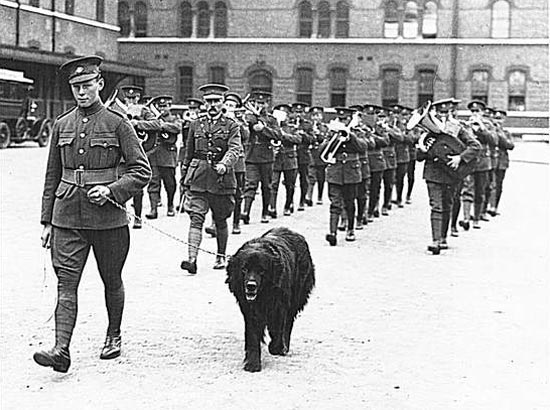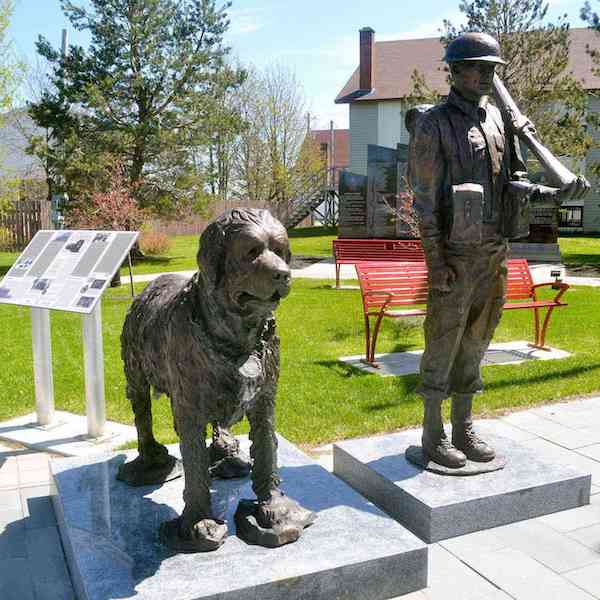
The Hayden family had named their Newfoundland, Pal,” and perhaps because they lived in Gander, Newfoundland, the dog was later renamed, “Gander,” by soldiers stationed at the RCAF Station Gander Air Base.
How had the dog gone from family pet to living with soldiers at an air base?
As part of the Hayden family, the gentle Newfoundland adored playing with the neighbor kids who often had him pull their sleds. During one playtime, however, “Pal” accidentally scratched a six year old with his big paw, and because the deep scratch required a doctor, the Haydens were faced with putting Pal down, or giving him away. They chose life for the 130 dog, and this is how Pal – soon to be Gander – became the regimental mascot for the 1st Battalion of the Royal Rifles of Canada.
When the the 1st Battalion was sent to Hong Kong in 1941, the men promoted Gander to the rank of “Sergeant”and took him along. They were called the C Force, a unit of 1,877 men, 96 officers and one dog – Sgt. Gander.
Hong Kong was hot! To help Gander cope with the heat, Rifleman Fred Kelly (entrusted to care for Gander) let him take long cold showers to help deal with the immense heat. The Newf was also reported to have a fondness for cool beer.
Gander, however, developed a dislike of Asians, probably related to the efforts of some locals to steal him. He got away, but only after a struggle, and Gander never forgot. His regiment didn’t discouraged Gander’s snarling and snapping, and this may explain why Gander had such a ferocious reaction to the enemy.
On December 7th, the Japanese attacked Pearl Harbor, and eight hours later, Japanese troops poured across the border in violation of international law since Japan had not declared war against the British Empire. They engaged British, Indian, and Canadian units, and alongside the Canadians was Gander.
The large dog charged and tackled any Japanese soldier who got too close to his Canadians troops. “He growled and ran at the enemy soldiers, biting at their heels,” recalled Rifleman Reginald Law. Since most of the fighting occurred at night, Gander’s black coat made him all but invisible, and instead of shooting the enormous dog, the Japanese tore off to avoid the “beast.”When Japanese soldiers interrogated Canadian prisoners of war, they asked about the “Black Beast,” suspicious that Allies were training vicious animals for battle.
It was during the Battle of Lye Mun that a grenade was thrown near a group of injured Canadians. It will never be known if Gander sensed the danger posed by a grenade was, but he picked it up with his mouth and ran off. Gander was killed in the explosion, but he had saved the lives of at least seven soldiers.
At the insistence of survivors of the battle, Gander’s name was listed among the 1,975 men and two women on the Hong Kong Veterans Memorial Wall in Ottawa, Ontario, Canada. On October 27, 2000, the People’s Dispensary for Sick Animals (the United Kingdom’s largest veterinary charity) awarded Gander the Dickin Medal, the animal equivalent of the Victoria Cross. It was the first such award since 1949, and was accepted by the late Fred Kelly of the Royal Rifles, Gander’s former handler, and in the presence of thirty-five Hong Kong veterans/POWs who attended the ceremony. The citation read:
For saving the lives of Canadian infantrymen during the Battle of Lye Mun on Hong Kong Island in December 1941. On three documented occasions, Gander, the Newfoundland mascot of The Royal Rifles of Canada, engaged the enemy as his regiment joined The Winnipeg Grenadiers, members of Battalion Headquarters “C” Force and other Commonwealth troops in their courageous defence of the island. Twice Gander’s attacks halted the enemy’s advance and protected groups of wounded soldiers. In a final act of bravery, the war dog was killed in action gathering a grenade. Without Gander’s intervention, many more lives would have been lost in the assault
In 2015, a statue of Sgt. Gander along with a statue of his handler (representing a member of the Royal Rifles of Canada) was unveiled at Gander Heritage Memorial Park in Gander, Newfoundland. Both were designed by local sculptor, Morgan McDonald. “It’s very emotional, even talking about it, it’s very close to my heart,” said Philip Doddridge, who had fought alongside Gander, and spent three years in a Japanese prisoner of war camp. “He was very much loved by all of us, he followed us to Hong Kong and was killed in action.”
Many accounts of Gander’s story have been written including a book, Sergeant Gander: A Canadian Hero, and photographs of Gander are easily found on the Internet. Sgt. Gander’s medal and award certificate, however, are now in the Canadian War Museum.
As of 2015, Gander remains Canada’s only decorated military animal.

